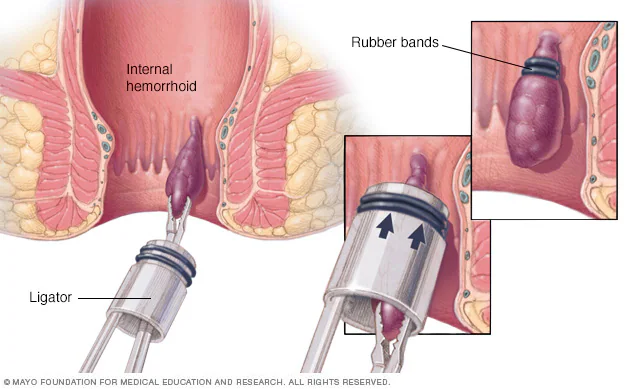Hemorrhoid Relief with Rubber Band Ligation

If you’ve ever felt like your backside was staging a rebellion, you’re not alone. Hemorrhoids are nature’s way of reminding us that we weren’t meant to sit for hours on end, scrolling through our phones on the toilet. But don’t worry—if you’re tired of dealing with the discomfort, itching, and surprise bleeding, rubber band ligation might just be the eviction notice your hemorrhoids need.
It’s quick, non-surgical, and highly effective, making it one of the most commonly performed treatments for internal hemorrhoids. If you’re done playing the long game with over-the-counter creams, it’s time to talk about how hemorrhoid relief with Rubber Band Ligation can be very simple.
What Is Rubber Band Ligation?
Rubber band ligation is a minimally invasive procedure used to cut off the blood supply to internal hemorrhoids, essentially starving them until they shrivel up and drop off—like an unwelcome guest who finally gets the hint. It’s a fast, effective treatment that doesn’t require surgery, anesthesia, or prolonged downtime.
How the Procedure Works (Step by Step)
Examination: The doctor uses an anoscope (a small tube with a light) to locate the hemorrhoid.
Band Placement: A small rubber band is placed around the hemorrhoid’s base using a special instrument.
Blood Supply Cut Off: The rubber band prevents blood from reaching the hemorrhoid, causing it to shrink.
Hemorrhoid Falls Off: In about a week, the hemorrhoid dies and detaches, usually during a bowel movement.
Healing Process: A small scar forms, preventing future hemorrhoids in that area.
Who Is a Good Candidate for Rubber Band Ligation?
If your hemorrhoids have overstayed their welcome, this procedure is perfect for you if:
You have internal hemorrhoids (Grade 1, 2, or 3) that bleed, prolapse, or cause discomfort.
You’ve tried every cream, wipe, and sitz bath known to mankind and still have issues.
You don’t want surgery but also don’t want to keep suffering.
⚠️ Who Should Avoid Rubber Band Ligation?
People with external hemorrhoids (RBL only works on internal ones!)
Those with blood clotting disorders
Individuals with severe hemorrhoids (Grade 4) that may require surgery
What to Expect During the Procedure
No Need for Anesthesia – This isn’t a major surgery; the whole thing takes just a few minutes.
Mild Pressure, Not Pain – You may feel a sense of fullness or slight discomfort, but nothing unbearable.
Multiple Sessions May Be Needed – If you have multiple hemorrhoids, they are usually treated one at a time, spaced a few weeks apart.
Recovery and Aftercare
The best part? You can walk out of the doctor’s office right after the procedure—no hospital gowns or long recovery times needed. But that doesn’t mean you won’t have some minor discomfort, because let’s face it, your rectum just got banded like a ponytail.
What to Do After the Procedure
✅ Drink plenty of water – Keeps things moving so you’re not straining.
✅ Eat fiber-rich foods – Think leafy greens, whole grains, and all things fiber.
✅ Use stool softeners if needed – No pushing, no problem.
✅ Avoid heavy lifting – Don’t make things worse.
✅ Take sitz baths – Warm water is your new best friend.
Possible Side Effects (Don’t Panic, They’re Normal)
Mild pain or discomfort (can last a few days)
A feeling of fullness or pressure in the rectum
Mild bleeding (especially when the hemorrhoid falls off)
Temporary urgency to have a bowel movement
⚠️ When to Call a Doctor
Severe pain that doesn’t improve with over-the-counter medication
Heavy bleeding that won’t stop
Signs of infection (fever, chills, increased swelling)
How Effective Is Rubber Band Ligation?
Rubber band ligation is one of the most effective non-surgical treatments for internal hemorrhoids. Studies show that 80-90% of patients experience long-term relief after the procedure.
However, if you go right back to constipated bathroom struggles, hours of sitting, and ignoring fiber, your hemorrhoids might make a comeback. The procedure works, but it doesn’t grant immunity against bad bathroom habits. If you want lasting relief, be kind to your rectum.
Why Rubber Band Ligation Works Better Than Other Treatments
Sclerotherapy – A chemical injection that shrinks hemorrhoids but has a higher recurrence rate than RBL.
Infrared Coagulation (IRC) – Uses heat to shrink hemorrhoids but may require multiple sessions.
Hemorrhoidectomy – Surgical removal of hemorrhoids for severe cases, but it comes with pain and a longer recovery time.
Stapled Hemorrhoidopexy – Works for prolapsed hemorrhoids, but not ideal for standard internal ones.
Alternatives to Rubber Band Ligation
If RBL doesn’t sound like your thing, here are some other treatment options:
Sclerotherapy – A chemical injection to shrink hemorrhoids.
Infrared Coagulation (IRC) – A heat-based treatment that cuts off blood supply.
Hemorrhoidectomy – Surgical removal of hemorrhoids (for severe cases).
Stapled Hemorrhoidopexy – A procedure that staples prolapsed hemorrhoids back into place.
Final Thoughts
Rubber band ligation is one of the easiest, most effective ways to get rid of internal hemorrhoids without surgery. If your hemorrhoids are persistent, bleeding, or prolapsing, this quick, minimally invasive procedure could be the relief you’ve been looking for.
And let’s be honest—no one wants to live their life afraid of the toilet. If hemorrhoids have been ruining your comfort, it’s time to take action. Talk to a doctor about whether rubber band ligation is right for you, and don’t forget: fiber is your best friend, straining is your worst enemy, and your phone does NOT belong in the bathroom.
Find more health tips and hemorrhoid treatment options.
